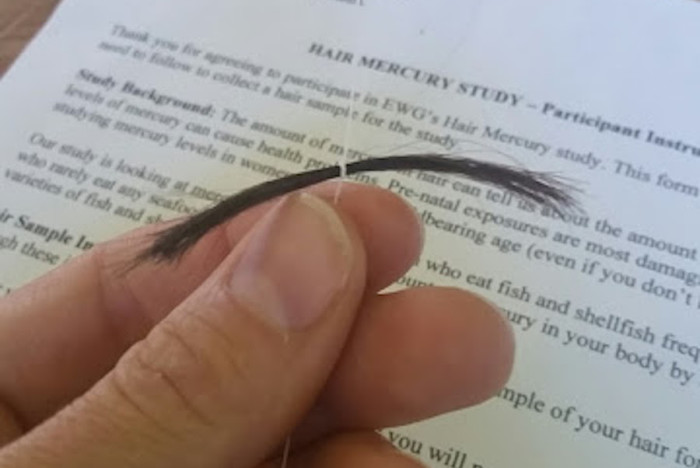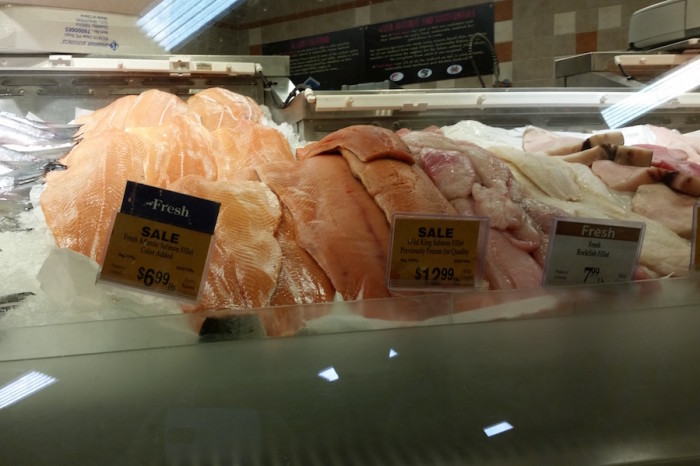
Like many in the Pacific Northwest, my friend Anne DeMelle loves salmon.
She even calls it her “default seafood,” and that’s exactly what it is for my family, too. Anne recently participated in a study by the Environmental Working Group (EWG) for women of reproductive age on seafood-related mercury contamination. The kind of mercury we get from seafood is excreted through our hair, so Anne lopped off a lock and mailed it in.
“The concentration of mercury in your hair sample was 2.5 parts per million,” said the response email she received from EWG in July, a couple of months after she sent in her hair.
You can imagine Anne’s shock when she received the results explaining that her mercury level was five times greater than what is recommended for women who are pregnant or of childbearing age.
Even though she wasn’t pregnant or trying, “it freaked me out,” she said.
“I knew it was going to be high, but … my body is a Superfund site right now.”
Six months later, it’s still 1.7 parts per million, and much higher than she expected after she tried to reduce her mercury intake. Since Anne participated in the study, her friends are turning to her for advice.
“I was with girlfriends, and they were asking me ‘What seafood can I eat?’… [T]hey were confusing mercury with PCBs (polychlorinated biphenyls), and they didn’t know how certain species are better than others,” she said. “They were pretty overwhelmed because it’s confusing.”
Anne and her friends’ conundrum is shared by many other women who want to buy seafood at a reasonable price. They know that third-party sustainability certifications don’t do a great job at informing consumers about toxin levels in seafood. They seek out information about the risks of seafood from sources they trust, including chefs, nutritionists and biologists, but advice is often limited. To improve women’s access to expert advice, the Center for Health and Global Environment created a video series to teach pregnant women about seafood.
Even the discerning seafood consumer with access to these resources, however, can’t figure out a way to know for sure how much mercury, arsenic, PCBs (a toxin banned since the ‘70s, but still in our local salmon) and PBDEs (flame retardants) are really in our salmon.

And while the nutritional advantages of eating fattier fish such as salmon are clear — especially for expectant mothers — it can come at a price. According to research by Dr. Emily Oken, an associate professor at Harvard Medical School and physician at Brigham and Women’s Hospital in Boston, 10 percent of all U.S. women of childbearing age, and a higher percentage of women who are older, Asian or live near the coasts, have mercury levels above recommended limits. Another study found that up to 15 percent of U.S. women of childbearing age have elevated mercury levels.
Shouldn’t our industry experts be concerned? When I brought up this women’s health issue at Sustainable Seafood Week Seattle last August, a man representing a local distributor replied, “Those fears of mercury contamination are unfounded.”
Many men I spoke with that day wrote me off similarly, and here they are in Seattle, leading some of the world’s most lucrative and far-reaching seafood brands.
Even though women control up to 80 percent of household purchasing and frequently dominate food purchasing and meal preparation, the seafood industry hasn’t been responsive to female consumers and the health safety guidance we need.
And because not enough local salmon can satisfy the Northwest’s demand for fish, many women are priced out of the market. In Washington state, we have the fourth largest population in the U.S. of working Latinas earning a median annual wage of $28,085 — or 46 cents to every dollar a white man earns. So we must sell fish in a market where women’s food budgets restrict what they can buy. And when farmed salmon has the omega-3 content of wild salmon at half the cost, we can expect the demand to continue.

In November, the U.S. Food and Drug Administration’s (FDA’s) approval of AquaBounty’s Genetically Engineered (GE) AquAdvantage® salmon for the U.S. market added another layer of uncertainty for consumers. On. Nov. 24 — two days before Thanksgiving — Costco Wholesale released a statement that it would not sell genetically modified salmon. Sixty other supermarket chains — including Safeway, Trader Joe’s, Target and Whole Foods — made the same commitment.
But other than the fact that AquaBounty claims “AquAdvantage® salmon do not contain toxins,” there’s nothing too fishy going on with the GE salmon. It’s essentially Atlantic salmon with two extra genes: one from Chinook salmon that produces a growth hormone, and one from an eel-like fish with antifreeze abilities that tells the other gene to produce these hormones. This allows the fish to grow year-round instead of only seasonally.
I spoke with Dr. Charles Santerre, an environmental toxicologist with a background in seafood and women’s health who attended FDA hearings on the AquAdvantage® salmon. In a phone interview, he told me that AquAdvantage® salmon will be similar to other farmed salmon because there are standardized fish feeds on the market used to control their nutritional profile.
Since the inserted genes are from salmon that we already eat, and producing proteins we already consume, there is no measurable risk that is any different from other farmed salmon, he explained. The benefits and risks of aquacultured seafood are controlled by how they are raised and what they are fed.
“The hard part with this whole topic is separating the hysteria and hype from the evidence and science,” said Dr. Santerre.
Fortunately, we can gauge risk based off of existing research on genetically engineered salmon. In her 2010 study, Dr. Anastasia Boder concluded: “Human health risks are no greater than that posed by other meats and animal products.” The only area that needed more research, according to Dr. Boder’s findings, was allergenic impacts.
Still, there’s a good reason why a lot of people fear technological changes when it has to do with food. Food is so intimately tied to our health and culture. The backlash of fear we are seeing now is a response to the poor track record of transparency the seafood industry and regulatory agencies have had so far.
“Even though the FDA has access to those results, the withholding of data from the public has only served to increase distrust of AquAdvantage salmon and of the FDA itself,” Dr. Bodner confirmed in her research.
Recent reports also reveal that rampant mislabeling in the industry creates even greater consumer distrust.
It’s already disturbingly normal that we don’t quite know what we’re getting in our seafood. Even Carl Safina, host of PBS’s “Save the Oceans,” accidentally overdosed on mercury-laden tuna, ending up with a mercury level five times higher than what would be considered safe — just like my friend Anne.
Fortunately, he wasn’t pregnant at the time. If he had been pregnant, or he had prepared this tuna often for his child, the child could have suffered negative health impacts.
If we can create safer seafood for women to eat, then all of our children will benefit, because omega-3’s have a positive impact on brain development.
And if AquaBounty and the FDA can figure out how to answer all of our questions with transparency and integrity, they have an excellent opportunity at winning over some women consumers in the Northwest whose trust they have lost.


An intelligent, balanced discussion and fact-based observations
Very helpful review of a complex issue. I learned a great deal.